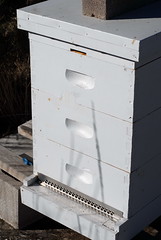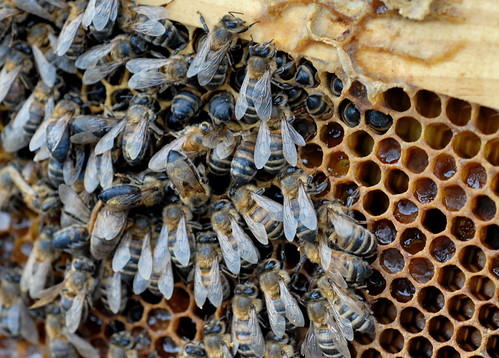Here are some of the conditions we observed:
The population of bees seemed good.
The bees were easily agitated during the inspection.
A few yellow-jackets were observed (under attack) while inspecting.
The upper and lower deeps were nearly void of all honey stores!
The brood area was spotty with some dead bees just emerging in brood area with their tongues outstretched (See photo). But, we didn't see any sunken or punctured cappings. Nor did we see any melted down larvae or black scale.
We had already treated for mites and we began feeding them immediately. The queen was also seen during the inspection (see photo). Also we observed no drones during this inspection, while during the summer they were several. But I think they have probably been given the boot by the ladies at this point in the season.
After we had a full top-feeder with that sweet syrup on for two weeks, they were not interested! Surprisingly there is no evidence they took any! We went out after the first week and topped it off, and checked again after two weeks and there might have been some evaporative loss, but very little if any. Also there were no visible bees in the screen area near the feeding opening.
We've had plenty of warm days in the first two weeks we fed them. We also saw them circulating about and even some congestion at the entrance late in the day.
We had some warm weather again on November 11, so we did another inspection of the troubled hive. There was some good news which was encouraging, but further mystery surrounds this hive.
First, we were all prepared to take the upper deep and push them down to just one deep for the winter, but when we opened the hive, we found good news - HONEY and lots of it. Mysteriously, there were now several very heavy frames completely capped with honey in this hive. I would estimate the upper deep at 50%-60% capped honey by that time! The frames that weren't full, were being worked furiously to store necter and get it capped. Here's a photo of one of those frames not yet filled:

Full Size Image
The mystery goes to the source of this new found honey. The top feeder was still full and there were still almost no bees feeding from the syrup in the top feeder. Where did they get all these new stores? Maybe they stole this honey from somewhere else?
Strangely, we also did see a number of dead yellow jackets floating in the syrup. How they got in, is also a mystery. Perhaps this is what made the syrup unappetizing for the bees? We cleaned it up and removed the dead yellow jackets, but left the syrup. Here is what that looked like:

Full Sized Image
Finally, we did see some brood and larvae in the upper frames:

Full Size Link
We also saw the queen on one of the brood frames, but didn't get a photo this time. After all this, we decided to leave the upper deep and keep feeding. I was a bit more hopeful they will make it by this time. I also saw one stray yellow jacket on the frames while we were inspecting and one later on the hive cover after we closed it up, but how they got into the hive-top-feeder has us puzzled. There were some small cracks between the frames, which seemed to be attracting some attention from the outside. Perhaps the yellow jackets were squeezing through? To make sure that wasn't happening, I sealed the cracks with some duct tape.
On January 5, 2008, we finally had another warm day and I went out for another look. The troubled hive was still alive with quite a few bees going in & out for some fresh air. However, it seemed to have a dysentery problem. That must have been what weakened them last winter and we didn't catch it.
Here are the shots I took when they were out on January 5th 2008:

Full Size Image Link

Full Size Image Link
And these pictures were taken of on January 26th showing the condition of the outside of the hive:

The troubled hive. Full Size Image

The healthy hive nearby. Full size image
The second hive seemed immaculate by comparison. At this point we were pretty sure it was some form of nosema. (Nosema causes dysentery and weakens the hive, reduces production, etc.) They were seen flying about on January 28th, but we didn't open the hive to see how many were alive.
On February 13th, we had another day in the 70s, but the battle had ended, the disease won, the bees lost.

BeeGood went out that day to assess the condition of the hives. There were a few bees out taking cleansing flights, but inside was a sad story. Most of the frames in the upper deep had clusters of dead bees. Many died with their heads deep into the comb, but even more died just as they were standing, stuck permanently in a somewhat natural pose. This picture shows there was some remaining bee-bread in the comb right where they died. Some honey was also found in other frames but very little - they surely starved. There were many small groups of dead bees scattered throughout the hive. There didn't seem to be any single cluster. The bees in the photo below looked natural in the photo, but all were motionless and dead:

View 1200x860 image
With it pretty clear they had nosema, I'm beginning to wonder if this was a case of the more severe Nosema ceranae strain.
Randy Oliver wrote:
Amazingly, in a few short years N. ceranae appears to have supplanted N. apis throughout much of North America and the world! In many areas, it is now difficult to find the previously common N. apis!... One European researcher feels that we have been so distracted by varroa, that we have simply overlooked the poor buildup, queen failures, poor honey crops, and colony collapse due to N. ceranae.
The good news was that the nearby hive #2, seems to be doing much better. After a quick peek into that hive, she verified that they still had good supplies of honey stores and had a much larger population. She decided not to start feeding after inspecting two nearly full frames, near the center of the upper box. This second (healthy) hive also seems to be amazingly clean compared to the dead hive. The wax and comb appears clean and very light colored, while the dead hive has very dark colored comb.




No comments:
Post a Comment